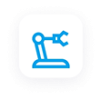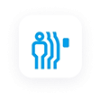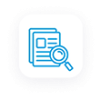Since the introduction of the first thermostat in the late 1880s, sensors have gradually become a part of our lives. They became more popular when infrared sensors were invented and used in the late 1940s. Today, sensors are everywhere, from our homes and factories to supply chain systems. On top of that, they are embedded in our smartphones and the Internet of Things (IoT).
What Are Sensors?
Sensors gather information or data from sources such as temperature, light, pressure, and motion and respond to the changes in their environment. These devices can share valuable information with other devices and management systems if connected to a network.
Sensors are an inevitable component of current business activities, including logistics operations. They can detect errors and give out warnings for potential problems. Hence, they aid businesses in avoiding more significant issues and costly downtimes and performing predictive maintenance. According to Statista, the international sensor market is projected to grow from $165 billion to $426 billion between 2019 and 2030, exceeding 200%.
Today, enterprises are deploying sensors from one end to the other in their supply chain. It will help track everything that passes through the desired logistic channel. Moreover, it reduces operation costs, aids strategy planning, and provides valuable insights.
Various types of sensors improve the efficiency of logistic operations, and here are the top three of them.
1. Safety Laser Scanners
A Safety Laser Scanner is an Electro-Sensitive Protective Device (ESPE) that conducts a Two-Dimensional (2D) scan of its surroundings using infrared laser beams. In other words, this device forms a laser field around it. If anything enters this laser field, the safety laser scanner detects the object and alerts the user or equipment, such as Output Signal Switching Device (OSSD). These sensors provide maximum protection for mobile and stationary applications.
2. LiDAR Sensors
Light Detection and Ranging or LiDAR sensors are critical obstacle detection devices in autonomous vehicles like Autonomous Mobile Robots (AMRs) and Automated Guided Vehicles (AGVs) in logistic operations. LiDAR sensors generate and measure millions of data points in real time. It creates a precise map of its ever-changing surroundings for safer navigation.
These sensors provide a high-resolution 2D or 3D view of their surroundings, enabling these autonomous vehicles to ‘see’ their surroundings. They are also used for obtaining distance data for presence detection, area monitoring, and spatial recognition.
3. Collision Avoidance Sensors
Collision Avoidance Sensors, also known as Collision Sensors (CAS), help a vehicle or crane detect an obstacle in their paths. It allows the automated system or the operator to take appropriate action to avoid a collision. CAS is usually fixed at the front and rear of a vehicle or logistic equipment. Once an obstacle is identified, the sensor may trigger an alarm or stop the equipment's functioning. They also offer complete runway detection for protecting property, equipment, and workers.
One of the most common CAS is a car proximity sensor that helps drivers detect obstacles when they reverse their vehicle. Collision Avoidance Sensors are also commonly used in AGVs and AMRs in factories and warehouses.
Sensors and Their Benefits in the Supply Chain
Sensors enhance automated data collection and processing in devices, factories, warehouses, and supply chains. It also broadens the visibility across the supply chain, helping companies reduce operating costs, improve efficiency, and generate more revenue. Listed below are a few ways in which sensors in the supply chain help organizations.
- Enhance operational efficiency through automation
- Reduce maintenance and repair costs as well as downtime through better monitoring
- Conducts real-time inventory tracking with improved demand planning
- Inform product development
- Solid product life cycle management
- Enhance interactive customer service
Conclusion
Innovations such as micro-sensor implants and biodegradable sensors have made sensors more dynamic, increasing their use cases. Latest wireless technologies offer more scalable and tailored connectivity solutions than traditional wireless networks. They are developed for devices that use higher bandwidth data in larger volumes. For example, Low-Power Wide-Area Networks (LPWAN) have reduced cost, power consumption, and range issues for sensors.
Since analytical tools continue to improve, extracting insights from sensor data is getting easier. Therefore, the time has arrived for enterprises to assess their supply chains for piloting sensors.
Need help selecting the right sensor for your logistic operations? Get in touch with one of our experts today!

 Factory Automation
Factory Automation Logistics Automation
Logistics Automation Process Automation
Process Automation Crane Collision Avoidance
Crane Collision Avoidance LiDAR/Obstacle Detection
LiDAR/Obstacle Detection Safety Laser Scanners
Safety Laser Scanners Optical Data Transmission
Optical Data Transmission Hot Metal Detectors
Hot Metal Detectors Laser Distance Sensor
Laser Distance Sensor Blog
Blog Whitepapers
Whitepapers Case Studies
Case Studies Infographics
Infographics